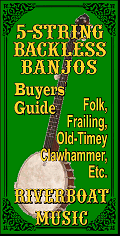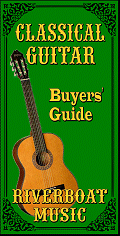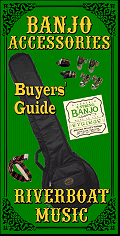Acoustic Instrument
Primers
What Kind of Guitar
Should I Start On?
What Kind of Banjo
Do I Want?
Evaluating and
Buying Used
Guitars
Setting Up
Fretted Instruments Whatever Happened
to the Banjo?
Beginning Five-
String Banjo
6-String Banjos
Banjo Pickups
Axes in my Life
What is a
Bluegrass Banjo?
Dean "Backwoods
Six" Shootout
Music Theory
Primers
Introduction
to Scales
Introduction
to Chords
Circle of Fifths
Other Articles
About Music
How to Give
Guitar Lessons
Musician or
Wannabe? Did God Really
Give Rock &
Roll to You?
Are You a
"Brand Bigot"?
Who Owns Folk Songs?
Historical Links
About the
National Road
The Story Behind
the Story - Real
People, Places,
and Events
About the Play
Play Home
What's New
Overview
About the
Music
About the
History
About the
Logistics
About the
Cast
Synopsis
About the
Set
About the
Author
Contact Us
Home



|

|



Beginning Five-String Folk Banjo - Part Six - Sliding and Sycopated Melody Lines
| Written by Paul Race for Creek Don't RiseTM and School Of The RockTM |
This is a follow-up to our article on Pulling off and More Melody. In fact, it's a very close follow-up because we're going to learn the rest of a song we started in lesson 5.
We'll shortly be introducing a new lick that a lot of people use when they play this, but we're going to start with learning to play the basic tune to the verse of "Cripple Creek" (We started learning the chorus in Lesson 5.
The melody itself is shown in the following score. By the way, a score like this one that shows only the melody, words, and chords is called a "lead sheet." Sometimes when you're asked to bring your banjo places, they'll hand you a piano/vocal score that has lots of information that doesn't apply to you, including a full piano part. If you know the tune very well, a "chord sheet," which shows just the chords and the words, may do the job. If you're not sure about the melody, or just want to have a better idea of how phrases fit together into the music, a lead sheet is a good compromise. If you're asked to accompany a song that actually has three or four different tunes, it's very helpful.
By the way, "Cripple Creek" is a folk song, and there are a number of different variations. This is not the variation I grew up with, but it's a version you're more likely to hear. If you're used to a slightly different variation, please feel free to sing or play it in a way that you are comfortable with.

Banjo Tab - The following tab shows a simple version of the banjo part for the whole song. If you look it over, the only part that is new to you is the first two measures, which are repeated in measures 5 and 6. The rest of the measures in the verse are exactly the same as measures you've already learned from the chorus.
To hear this arrangement, click this logo: 

Slide
Now, many folks play this song very much like the way it is presented above. But some add another technique to the very first note on measures 1 and 5, called a slide.
Now here's the last thing you need to know about "Cripple Creek": Many pickers use slides everywhere you do the Bb-B hammer. They time the slide so that their finger frets the fourth fret exactly when it would if they were hammering on. So if you wanted to show that, you'd simpy put in the little arrows and replace the little H's with little S's. I'm not going to do that for you, since I think you can figure that out for yourself.
Using Syncopation to Simplify Melody Picking
You'll remember how we included passing tones to "flesh out" the melody in "This Little Light of Mine"? The "downside," of that is that you break the rhythm of your roll when ever you substitute a quarter note for the second half of your "bum-ditty" pattern. You can see that in the first line of "This Little Light of Mine" as we presented it earlier.By the way, I promise this is the last time we will use this song for an example! It's just been so useful up 'till now.

Many pickers get around that by using hammering, pulling off, or slides to move that quarter note ahead half a beat, which makes room for the rest of the pattern. Compare the following line to the illustration above to see what I mean.

In fact, some old banjo tunes have been played this way so long that they sound funny if you play them "right." Understanding how this works will help you make sense out of other tabs, and will help you get around some awkward places in tunes you're trying to adapt for banjo yourself later on.
 Relative Minor
Relative Minor
We have also added a new chord - well, part of new chord: E minor (Em for short). It is ordinarily played the way we show it at the right. It is harmonically related to the key of G. Musicians call this the "Relative Minor" of the G major chord. Some folks also call it the "6th" or indicate it as a "vi" in written arrangements, because E is the sixth note of the G scale. And when you're in the key of G, the chord that starts with E will be minor (E-G-B).
In this arrangement, we add a little variety on the third line, by temporarily dipping down to an Em chord where we have been staying on G in the past. If you were singing this line, you would play the full E minor chord as part of your accompaniment, but since you're playing it as a solo, you can only squeeze in part of the chord, the E note on the second fret of the first string.
The following tab shows "This Little Light of Mine" with melody syncopated throughout. Moving some of the notes forward half a beat may actually be challenging until you get used to it. Most specifically:
- You'll notice that you have a new "hammering on" lick in measure 5, going from the second to the fourth fret on the fourth string. If you can't hit the rest of the C chord right after that, just ignore the first half of the fourth beat and play the high G on the second half.
- You also have a new "pulling-off" challenge in measure 7, going from the fifth fret of the fourth string to the second fret. If that's too much trouble for you right now, just play that measure the way you did in Lesson 4. To hear this banjo part, click this icon:

Conclusion
So far we have focused on the kind of banjo playing you're most likely to hear at places where people bring banjos, such as Bluegrass jams, etc. We've also focused on the kinds of things you're mostly like to encounter when you try to play other people's tabs. In fact, there are literally hundreds of tabs on the internet that you should be able to work out without learning any new concepts beyond this point. But we want you to grow as a musician beyond the "reading other people's tabulature" stage. There are a lot of banjo owners who can blow the brackets off their banjos as long as they're in certain keys playing certain rhythms, but completely fall apart if you get them out of their very narrow "comfort zone." Hopefully we can help you get beyond that and become an actual musician if you stick with it.Lesson Seven, 3/4 Time and More about Chords, may seem a little tough at first, and - the truth is - it's out of a lot of people's comfort zones, but it's a step toward getting you out of the "I can play certain kinds of songs like a bat out of hell but get lost on everything else" trap.
In the meantime please contact us if you have any questions or hit any brick walls.
All material, illustrations, and content of this web site is copyrighted © 2001, 2002, 2003, 2004, 2005, 2006,
2007, 2008, 2009, 2010, 2011, 2012, 2013, 2014, 2015 by Paul D. Race. All rights reserved.
Creek Dont' Rise(tm) is a participant in the Amazon Services LLC Associates Program, an affiliate advertising
program designed to provide a means for sites to earn advertising fees by advertising and linking to Amazon.com.
For questions, comments, suggestions, trouble reports, etc. about this play or about this web page, please contact us.
| Visit related pages and affiliated sites: | ||||||
| - Music - | ||||||

|
 |
 |

|

|

|
|

|

|

|

|

|

|
|
| - Trains and Hobbies - | ||||||
 |

|

|  |
 |

|
|
| - Christmas Memories and Collectibles - | ||||||
 |

|
 |

|
 |

|
|
| - Family Activities and Crafts - | ||||||
 |

|

|

|

|

|
|



